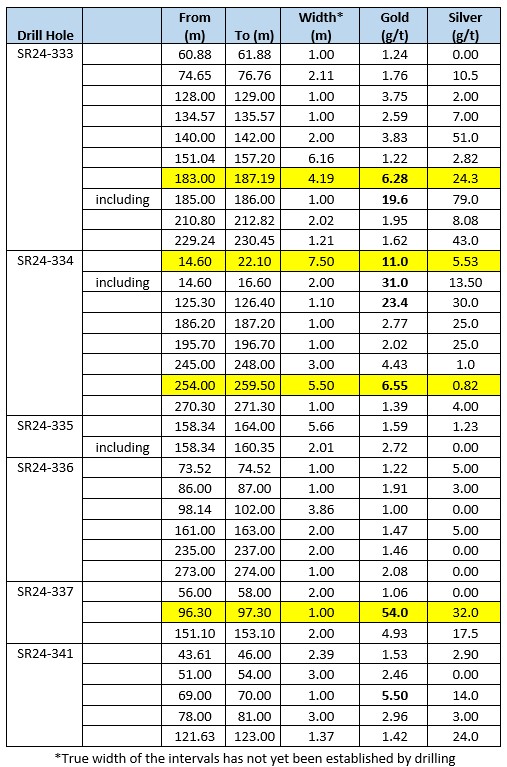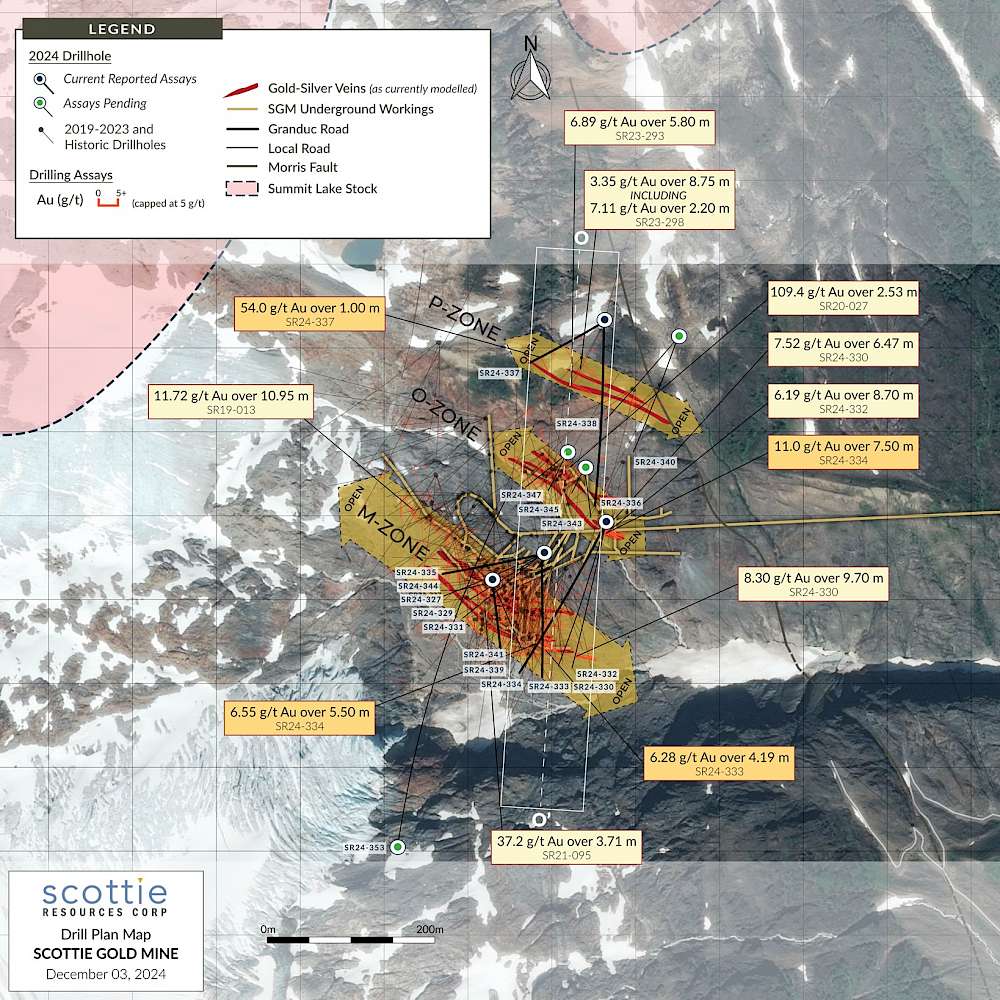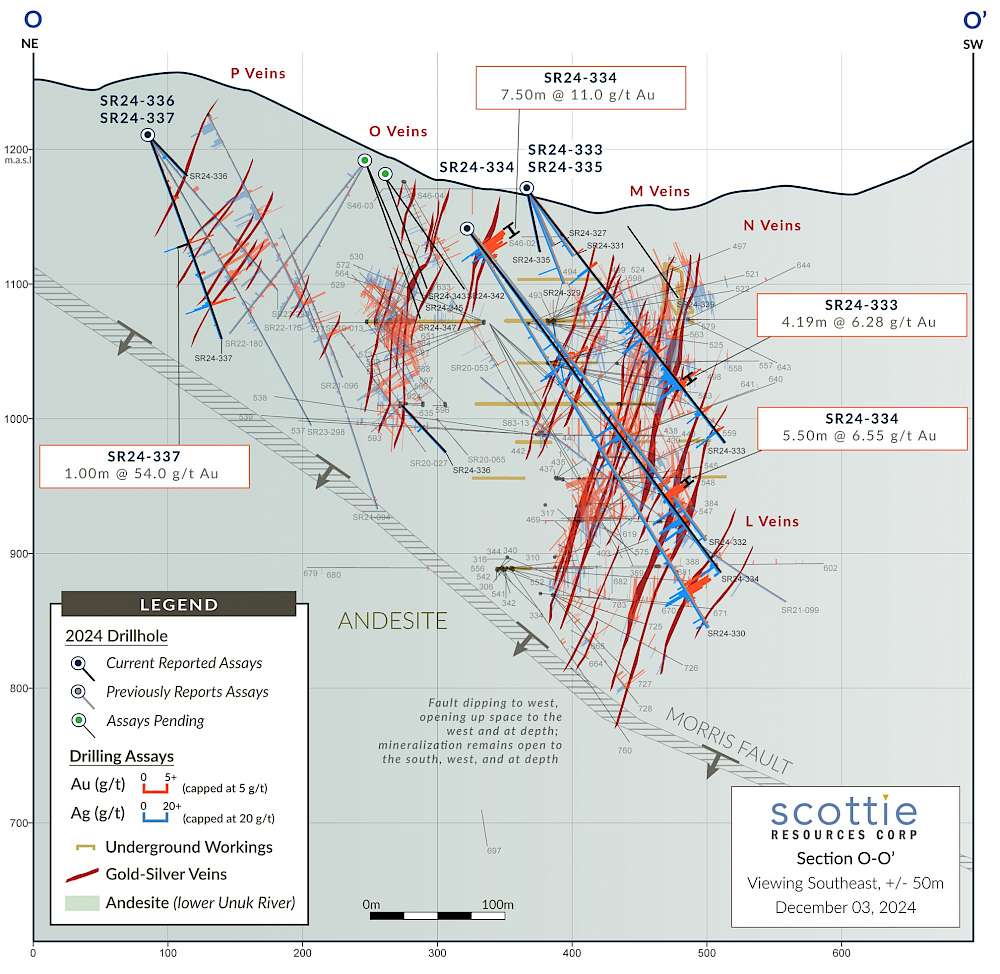Scottie Resources Intercepts 11.0 g/t Gold over 7.5 m and 6.55 g/t over 5.5 m at Scottie Gold Mine
Vancouver, BC – December 3, 2024 – Scottie Resources Corp. (“Scottie” or the “Company”) (TSXV: SCOT OTCQB: SCTSF FSE:SR8) is pleased to report new assays from its 2024 drilling of the P-, O-, M-, and N Zone’s at the historic Scottie Gold Mine (SGM). The Scottie Gold Mine Project, which includes the 100% owned historic mine and the adjacent Blueberry Contact Zone is located 35 kilometres north of the town of Stewart, BC, along the Granduc Road.
Highlights:
- SGM – drillhole SR24-334 intersected 11.0 grams per tonne (g/t) gold over 7.50 metres (m) including 31.0 g/t gold over 2.00 m in the O Zone and intersected 6.55 g/t gold over 5.50 m at the N Zone (Table 1, Figures 1,2)
- SGM – drillhole SR24-333 intersected 6.28 g/t gold over 4.19 m including 19.6 g/t gold over 1.00 m (Table 1, Figures 1,2) at the N Zone
- P Zone SGM drillhole SR24-337 intersected 54.0 g/t gold over 1.00 m, representing a 35 m step-out to the northwest in a wide-open direction
President and CEO, Brad Rourke commented: “Drilling at the Scottie Gold Mine this year was primarily driven by the objective to include the historic deposit into the upcoming resource estimate, nonetheless the recent results continue to show that there is significant expansion potential around the mine and the existing infrastructure. The new data has already generated additional high-confidence targets for next years program, that will fuel the continued expansion of known zones, and test new concepts. We feel that there is much more growth and discovery potential in and around the Scottie Gold Mine and plan to allocate a substantial portion of future drill programs to demonstrate the upside.”
Table 1: Selected results from new drill assays (uncut) from the Scottie Gold Mine, P, O, M, and N Zones

The Scottie Gold Mine, which operated between 1981 to 1985, produced 95,426 gold ounces from 183,147 tonnes at an average recovered grade of 16.2 g/t gold. The mine ultimately shut down due to a drop in gold price combined with high-interest rate on the initial mine startup loan. When the mine shutdown, the deposit had over two years of production left in what the mine considered to be reserves (this historical estimate is not consistent with CIM Definition Standards for Mineral Resources & Mineral Reserves and is not treated as such). The 2024 diamond drill program was designed to validate the historical drill results, extend known zones, and test new targets around the past-producing mine.

Figure 1: Overview plan view map of the Scottie Gold Mine, illustrating known mineralized zones, historic underground workings, and the distribution of the collars and traces of the 2024 drill holes.
Historical drilling of the Scottie Gold Mine was largely focused on mine production, with little work done on proving up substantial resources. The majority of historical drilling was done from underground, and therefore consisted of short holes with single targets – with very restricted drill pad locations. Recent exploration by Scottie has used the benefits of drilling from surface to target areas that were inaccessible with underground drill locations, and where possible to test multiple targets with individual holes.

Figure 2: Cross-section highlighting the recent intercepts in SR23-333, -334, and 337 relative to recent and historical drilling of the Scottie Gold Mine and the various vein zones within it. Note that the orientation of the Morris fault is such that it dips down to the west, creating space at depth the further west the veins strike.
About the Scottie Gold Mine Project
Mineralization consists of east-west to northwest trending, steeply dipping, shear veins, that are comprised of pyrrhotite > pyrite ± quartz ± calcite. The veins are hosted in a package of andesitic volcanic rocks from the Hazelton Unuk River Formation that are situated adjacent to the contact with the Summit Lake stock, part of the Texas Creek Plutonic Suite. While 13 distinct gold-bearing vein zones have been identified on the Scottie Gold Mine Project, mine production was primarily from one vein (the M-zone).
Exploration of the Scottie Gold Mine Project over the past 6 years has produced exceptional drill results through the discovery of high-grade gold in four new zones (Blueberry Contact Zone, Domino, D-Zone, P-Zone) and the expansion of previously drill confirmed targets (Scottie Gold Mine, C-Zone, Bend Vein, Stockwork). There is a clear spatial relation between the outcropping and drill-confirmed high-grade gold targets and the contact with the Jurassic aged, Texas Creek Plutonic suite intrusion. Geological work in the area has established strong connections between the various deposits. The chemical, mineralogical, structural, and age relationships of the deposits and host rocks support a genetic model whereby all deposits are linked to the same mineralizing event.
About the Scottie Gold Mine
The Scottie Gold Mine, which operated between 1981 to 1985, produced 95,426 gold ounces from 183,147 tonnes at an average recovered grade of 16.2 g/t gold. The mine ultimately shut down due to a drop in gold price combined with high-interest rates. Mineralization consists of east-west to northwest trending, steeply dipping, shear and extensional veins, that are comprised of pyrrhotite > pyrite ± quartz ± calcite. The veins are hosted in a package of andesitic volcanic rocks from the Hazelton Group - Unuk River andesite unit that are situated adjacent to the contact with the Summit Lake stock, part of the Texas Creek Plutonic suite. While 13 distinct gold-bearing vein zones have been identified on the Scottie Gold Mine Project, mine production was primarily from one vein zone (the M-zone).
Historical drilling of the Scottie Gold Mine was largely focused on mine production, with little work done on proving up substantial resources and reserves. The majority of historical drilling was done from underground, and therefore consisted of short holes with single targets – with very restricted drill pad locations. Recent exploration by Scottie has used the benefits of drilling from surface to target areas that were inaccessible with underground drill locations, and where possible to test multiple targets with individual holes. The Scottie Gold Mine is located on the Granduc Road, 20 km north of the Ascot Resources’ Premier Project, which is in the process of refurbishing their mill in anticipation of production in Q1 2024.
Quality Assurance and Control
Results from samples taken during the 2024 field season were analyzed at SGS Minerals in Burnaby, BC. The sampling program was undertaken under the direction of Dr. Thomas Mumford. A secure chain of custody is maintained in transporting and storing of all samples. Gold was assayed using a fire assay with atomic absorption spectrometry and gravimetric finish when required (+9 g/t gold). Analysis by four acid digestion with multi-element ICP-AES analysis was conducted on all samples with silver and base metal over-limits being re-analyzed by emission spectrometry.
Dr. Thomas Mumford, P.Geo., a qualified person under National Instrument 43-101, has reviewed the technical information contained in this news release on behalf of the Company.
ABOUT SCOTTIE RESOURCES CORP.
Scottie owns a 100% interest in the Scottie Gold Mine Property which includes the Blueberry Contact Zone and the high-grade, past-producing Scottie Gold Mine. Scottie also owns 100% interest in the Georgia Project which contains the high-grade past-producing Georgia River Mine, as well as the Cambria Project properties and the Sulu and Tide North properties. Altogether Scottie Resources holds approximately 58,500 hectares of mineral claims in the Stewart Mining Camp in the Golden Triangle.
The Company’s focus is on expanding the known mineralization around the past-producing mines while advancing near mine high-grade gold targets, with the purpose of delivering a potential resource.
All of the Company’s properties are located in the area known as the Golden Triangle of British Columbia which is among the world’s most prolific mineralized districts.
Additional Information
Brad Rourke
President and CEO
+1 250 877 9902
Gordon Robb
Business Development / IR
+1 250 217 2321
Forward Looking Statements
This news release may contain forward‐looking statements. Forward looking statements are statements that are not historical facts and are generally, but not always, identified by the words “expects”, “plans”, “anticipates”, “believes”, “intends”, “estimates”, “projects”, “potential” and similar expressions, or that events or conditions “will”, “would”, “may”, “could” or “should” occur. Although the Company believes the expectations expressed in such forward‐looking statements are based on reasonable assumptions, such statements are not guarantees of future performance and actual results may differ materially from those in forward looking statements. Forward‐looking statements are based on the beliefs, estimates and opinions of the Company’s management on the date such statements were made. The Company expressly disclaims any intention or obligation to update or revise any forward‐looking statements whether as a result of new information, future events or otherwise.
Neither TSX Venture Exchange nor its Regulation Services Provider (as that term is defined in the policies of TSX Venture Exchange) accepts responsibility for the adequacy of accuracy of this release.
